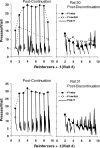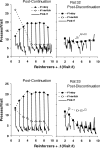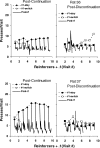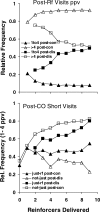Fix and sample with rats in the dynamics of choice
- PMID: 16903492
- PMCID: PMC1592352
- DOI: 10.1901/jeab.2006.57-05
Fix and sample with rats in the dynamics of choice
Abstract
The generality of the molar view of behavior was extended to the study of choice with rats, showing the usefulness of studying order at various levels of extendedness. Rats' presses on two levers produced food according to concurrent variable-interval variable-interval schedules. Seven different reinforcer ratios were arranged within each session, without cues identifying them, and separated by blackouts. To alternate between levers, rats pressed on a third changeover lever. Choice changed rapidly with changes in component reinforcer ratio, and more presses occurred on the lever with the higher reinforcer rate. With continuing reinforcers, choice shifted progressively in the direction of the reinforced lever, but shifted more slowly with each new reinforcer. Sensitivity to reinforcer ratio, as estimated by the generalized matching law, reached an average of 0.9 and exceeded that documented in previous studies with pigeons. Visits to the more-reinforced lever preceded by a reinforcer from that lever increased in duration, while all visits to the less-reinforced lever decreased in duration. Thus, the rats' performances moved faster toward fix and sample than did pigeons' performances in previous studies. Analysis of the effects of sequences of reinforcer sources indicated that sequences of five to seven reinforcers might have sufficed for studying local effects of reinforcers with rats. This study supports the idea that reinforcer sequences control choice between reinforcers, pulses in preference, and visits following reinforcers.
Figures















References
-
- Aparicio C.F, Cabrera F. Choice with multiple alternatives: The barrier choice paradigm. Mexican Journal of Behavior Analysis. 2001;27:97–118.
Publication types
MeSH terms
LinkOut - more resources
Full Text Sources

